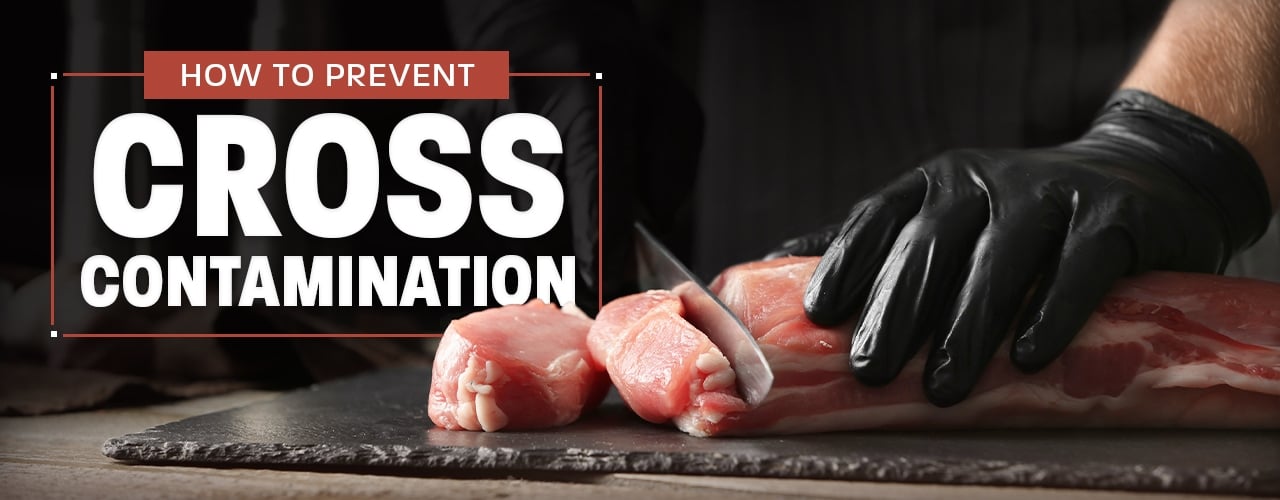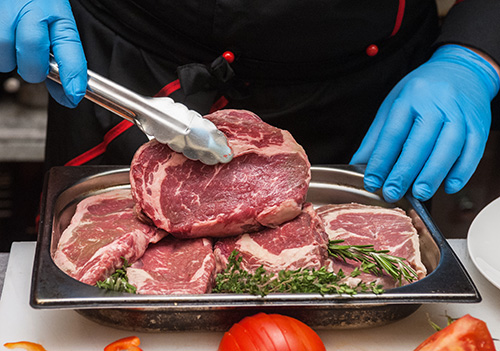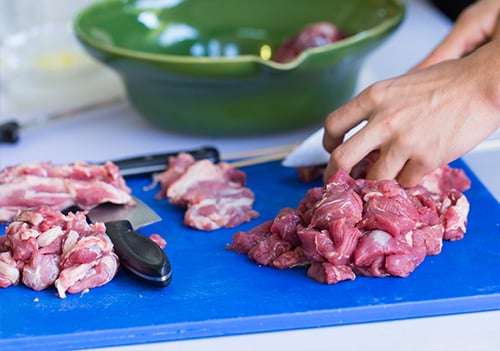
Cross-contamination occurs when harmful bacteria is transferred to foods, which can result in serious health risks like food poisoning or unintended exposure to food allergens. If your kitchen staff members know how to prevent cross-contamination by correctly storing and preparing food, you can save the time and money that would be wasted on improperly handled food.
By making the effort to separate your foods while storing and preparing them, sanitizing your kitchen surfaces and equipment, and practicing proper personal hygiene, you can create a kitchen environment that follows food safety guidelines.
What is Cross-Contamination?

Cross-contamination occurs when disease-causing microorganisms, like bacteria and viruses, are transferred from one food to another. As a result, cross-contamination is one of the leading causes of foodborne illnes. Cross-contact is most frequently caused by unwashed cutting boards, hands, or kitchen tools like knives and tongs.
While cooking to food-safe temperatures will kill dangerous bacteria, most food contamination happens when the bacteria from a raw food item interacts with food that doesn't need to be cooked.
How to Prevent Foodborne Illness
You can best prevent foodborne illness by being aware of the risk for contamination in each step of your food preparation process. It is possible to contaminate food before it is prepared, during preparation, and even when food is served to your customer. Implementing a HACCP program, or Hazard Analysis and Critical Control Points program, will help you to identify and control contamination risks.
Teaching all of your staff how to prevent cross-contamination can help your food stay safe from the moment it arrives in your kitchen to its delivery at your guests' tables. By requiring your kitchen staff to obtain food handling certification or food handler's permits, you can further ensure that your kitchen is a safe and sanitary environment.
Preventing Cross-Contamination through Food Storage
You can avoid contaminating food before it is prepared by using the correct food storage techniques. Proper food storage in the refrigerator is important to prevent cross-contamination, as many types of food are often stored in one place. In this environment, contaminants can easily spread from one food item to another if they have not been adequately protected or organized appropriately. When organizing your kitchen, follow these guidelines for safely storing food:
- Keep raw meats and dairy in well-sealed, sturdy food storage containers to prevent contact with other foods.
- ServSafe recommends storing food in the following order from top to bottom based on the minimum internal cooking temperature of each product: ready to eat food, seafood, whole cuts of beef and pork, ground meat and ground fish, whole and ground poultry.
- If space and budget allow, store your raw meats and dairy items in separate refrigeration units from your fruits, vegetables, and other ready-to-eat items.
- Clean your surfaces before preparing food on them, and be sure to sanitize them between uses. Failing to clean a work surface after preparing raw meat will contaminate any food items or equipment that you place on it afterwards.
- For added safety, use color-coded cutting boards to differentiate between supplies that are used for raw meat, fish, poultry, fruits, and vegetables.
- Try using color-coded chef knives to easily designate your knives for the same reason. Following HACCP guidelines for color-coded knives, green knives should be used with fresh produce, white knives for dairy, yellow with raw poultry, red with raw meat, blue for raw fish, and brown knives are meant to be used with cooked meat.
- To prevent contamination, equipment should be kept separate from food storage areas once it has been cleaned and sanitized.
- Require your kitchen staff to wear aprons and headwear to protect food from outside contaminants carried on the body or clothes.
- To best keep hands free from contamination, have employees wear disposable gloves and make sure that gloves are changed when an employee begins handling a new food or material.
- Also have employees wash their hands frequently and thoroughly, especially when handling raw meat, fish, or poultry.
- When plating prepared food, avoid using the same utensils to serve different food items. Have one for meat, fish, and poultry, and another for sides like vegetables or starches.
- Never put ice or garnish into a glass with your bare hands, but instead use a scoop or tongs.
- Always hold utensils by their handles and not by the portions that will come in contact with your patrons’ food.
- Similarly, have your servers handle your guests’ dishes by their base, without touching any portions of the plate where the food may go.
- Probe wipes are essential for sterilizing probe thermometers after each use.
- Because they are used only once, disposable food thermometers help to eliminate the risk of cross-contamination.
- Day of the week and product labels allow you to clearly label food items in your storage areas, so your employees know what is being stored and when it is safe for consumption.
- Try color-coded probe thermometers to prevent cross-contamination while ensuring that your foods are cooked to safe temperatures.
Preventing Cross-Contamination During Food Preparation
Even if food has been stored properly, there are still opportunities for cross-contamination once your staff starts preparing meals. Use the following preparation practices to avoid cross-contamination of foods:

Practicing Proper Personal Hygiene
Sometimes, contaminants linger on your employees’ hands and clothing. Here are some ways to prevent cross-contamination from improper hygiene habits:
Handling Food Safely
Preventing contamination is not finished until the food is brought to your customer’s table. This being said, cross-contamination can happen if utensils, glasses, and plates are improperly handled while your tables are set or cleared. To prevent contamination when serving food to your guests, consider the following tips on how to handle food safely:
Products for Preventing Cross-Contamination
Now that you know how to avoid cross-contamination in your preparation processes, consider these products that make practicing sanitary habits easier.
To prevent cross-contamination in your kitchen, it is important to practice sanitary habits throughout your food preparation processes. Food can be contaminated as early as during storage, and as late as during serving. Keeping your food safe means familiarizing yourself and your employees with techniques and products for preventing cross-contamination. You can refer to this article as a guide for beginning the practices that will help you run a safe and sanitary kitchen.





